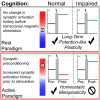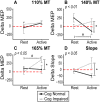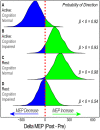Transcranial magnetic stimulation reveals diminished homoeostatic metaplasticity in cognitively impaired adults
- PMID: 33376989
- PMCID: PMC7750948
- DOI: 10.1093/braincomms/fcaa203
Transcranial magnetic stimulation reveals diminished homoeostatic metaplasticity in cognitively impaired adults
Abstract
Homoeostatic metaplasticity is a neuroprotective physiological feature that counterbalances Hebbian forms of plasticity to prevent network destabilization and hyperexcitability. Recent animal models highlight dysfunctional homoeostatic metaplasticity in the pathogenesis of Alzheimer's disease. However, the association between homoeostatic metaplasticity and cognitive status has not been systematically characterized in either demented or non-demented human populations, and the potential value of homoeostatic metaplasticity as an early biomarker of cognitive impairment has not been explored in humans. Here, we report that, through pre-conditioning the synaptic activity prior to non-invasive brain stimulation, the association between homoeostatic metaplasticity and cognitive status could be established in a population of non-demented human subjects (older adults across cognitive spectrums; all within the non-demented range). All participants (n = 40; age range, 65-74, 47.5% female) underwent a standardized neuropsychological battery, magnetic resonance imaging and a transcranial magnetic stimulation protocol. Specifically, we sampled motor-evoked potentials with an input/output curve immediately before and after repetitive transcranial magnetic stimulation to assess neural plasticity with two experimental paradigms: one with voluntary muscle contraction (i.e. modulated synaptic activity history) to deliberately introduce homoeostatic interference, and one without to serve as a control condition. From comparing neuroplastic responses across these experimental paradigms and across cohorts grouped by cognitive status, we found that (i) homoeostatic metaplasticity is diminished in our cohort of cognitively impaired older adults and (ii) this neuroprotective feature remains intact in cognitively normal participants. This novel finding suggests that (i) future studies should expand their scope beyond just Hebbian forms of plasticity that are traditionally assessed when using non-invasive brain stimulation to investigate cognitive ageing and (ii) the potential value of homoeostatic metaplasticity in serving as a biomarker for cognitive impairment should be further explored.
Keywords: TMS; cognitive ageing; dementia; mild cognitive impairment; plasticity.
© The Author(s) (2020). Published by Oxford University Press on behalf of the Guarantors of Brain.
Figures






Similar articles
-
Acute social and somatic stress alters cortical metaplasticity probed with non-invasive brain stimulation in humans.Int J Psychophysiol. 2021 Dec;170:1-5. doi: 10.1016/j.ijpsycho.2021.09.004. Epub 2021 Sep 20. Int J Psychophysiol. 2021. PMID: 34547303
-
Increasing motor cortex plasticity with spaced paired associative stimulation at different intervals in older adults.Eur J Neurosci. 2017 Dec;46(11):2674-2683. doi: 10.1111/ejn.13729. Epub 2017 Oct 26. Eur J Neurosci. 2017. PMID: 28965371 Clinical Trial.
-
Preconditioning human pharyngeal motor cortex enhances directional metaplasticity induced by repetitive transcranial magnetic stimulation.J Physiol. 2020 Nov;598(22):5213-5230. doi: 10.1113/JP279977. Epub 2020 Sep 3. J Physiol. 2020. PMID: 32804405
-
Metaplasticity in human cortex.Neuroscientist. 2015 Apr;21(2):185-202. doi: 10.1177/1073858414526645. Epub 2014 Mar 11. Neuroscientist. 2015. PMID: 24620008 Review.
-
Transcranial magnetic stimulation as a tool to induce and explore plasticity in humans.Handb Clin Neurol. 2022;184:73-89. doi: 10.1016/B978-0-12-819410-2.00005-9. Handb Clin Neurol. 2022. PMID: 35034759 Review.
Cited by
-
Step-by-step approach: Stereotaxic surgery for in vivo extracellular field potential recording at the rat Schaffer collateral-CA1 synapse using the eLab system.MethodsX. 2023 Dec 29;12:102544. doi: 10.1016/j.mex.2023.102544. eCollection 2024 Jun. MethodsX. 2023. PMID: 38283759 Free PMC article.
-
Intraclass Correlation in Paired Associative Stimulation and Metaplasticity.NeuroSci. 2022 Oct 25;3(4):589-603. doi: 10.3390/neurosci3040042. eCollection 2022 Dec. NeuroSci. 2022. PMID: 39483766 Free PMC article.
-
A naturalistic study comparing the efficacy of unilateral and bilateral sequential theta burst stimulation in treating major depression - the U-B-D study protocol.BMC Psychiatry. 2023 Oct 10;23(1):739. doi: 10.1186/s12888-023-05243-4. BMC Psychiatry. 2023. PMID: 37817124 Free PMC article.
-
Cortical excitability and plasticity in Alzheimer's disease and mild cognitive impairment: A systematic review and meta-analysis of transcranial magnetic stimulation studies.Ageing Res Rev. 2022 Aug;79:101660. doi: 10.1016/j.arr.2022.101660. Epub 2022 Jun 6. Ageing Res Rev. 2022. PMID: 35680080 Free PMC article.
-
Input-output slope curve estimation in neural stimulation based on optimal sampling principles.J Neural Eng. 2021 May 28;18(4):10.1088/1741-2552/abffe5. doi: 10.1088/1741-2552/abffe5. J Neural Eng. 2021. PMID: 33975287 Free PMC article.
References
-
- Abbott LF, Nelson SB. Synaptic plasticity: taming the beast. Nat Neurosci 2000; 3: 1178–83. - PubMed
-
- Abraham WC. Metaplasticity: tuning synapses and networks for plasticity. Nat Rev Neurosci 2008; 9: 387–99. - PubMed
-
- Abraham WC, Bear MF. Metaplasticity : plasticity of synaptic. Trends Neurosci 1996; 19: 126–30. - PubMed
-
- Abraham WC, Robins A. Memory retention—the synaptic stability versus plasticity dilemma. Trends Neurosci 2005; 28: 73–8. - PubMed
-
- Amatniek JC, Hauser WA, DelCastillo-Castaneda C, Jacobs DM, Marder K, Bell K, et al. Incidence and predictors of seizures in patients with Alzheimer’s disease. Epilepsia 2006; 47: 867–72. - PubMed
Grants and funding
LinkOut - more resources
Full Text Sources
Medical
